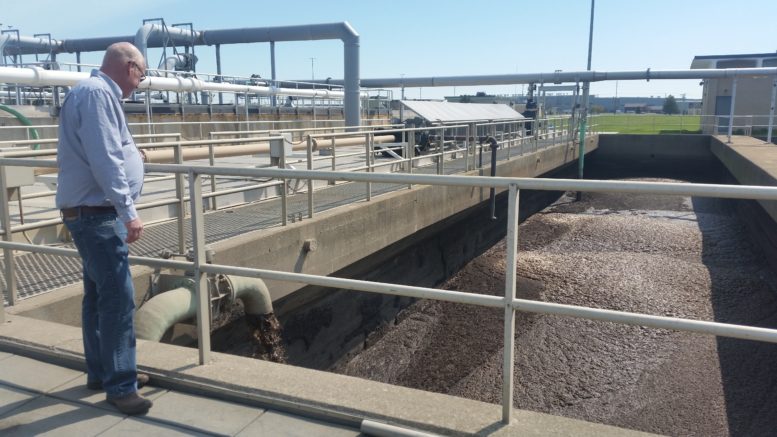By JAN LARSON McLAUGHLIN
BG Independent News
The plant that treats Bowling Green’s sewage isn’t accustomed to getting compliments from its neighbors about smells emitted from the site. But recently, the plant superintendent got some thank you notes about the lack of foul odors.
That was welcome news to Doug Clark, superintendent of the Water Pollution Control Plant on Dunbridge Road.
And that means that the recent investments made by the city in odor control are working.
In the past, the wastewater plant made several attempts to sweeten the smells emitted. It uses an aerobic digestion process with bacteria that helps consume the waste.
To lower the ammonia content, the wastewater is run through filters layered with large rocks, then smaller porous rocks, then root material. That process gets rid of some odors, but “quite frankly, not the most offensive ones,” Clark said in 2016.
The complaints continued – primarily from neighboring businesses and Bowling Green State University.
So Clark and Brian O’Connell, director of public utilities for the city, visited the wastewater plant in Harrisburg, Pennsylvania, which uses activated carbon to take out all the remaining odors that aren’t stopped by the aerobic digestion process.
“It’s the belts and suspenders part of the equipment that takes care of the odors that get through the biofilter,” O’Connell said after their visit. “We’re hopeful it will benefit us the same way.”
The Bowling Green facility staff believed the two likely sources of the stench were the septage receiving station and the biofilter that removes the bacteria from the waste and turns it into a harmless solid. A misting odor neutralizer was added to the biofilter’s exhaust fan in 2016, but it had limited success. The septage station had no odor control.
“The odors can be quite foul,” O’Connell said. “We’ve tried to get this problem licked in the past,” but the fixes always proved to be temporary.
The Pennsylvania plant installed a carbon filter system to treat the exhaust air for odors. That change ended all odor complaints, including from the Holiday Inn located right next to that plant, O’Connell said.
The permit for the Pennsylvania plant allows for “zero odor discharge from the perimeter,” Clark said.
So Bowling Green purchased a larger exhaust fan, additional air piping and two carbon filter vessels for the biofilter. The two tanks would allow for one to serve as a backup. To combat odors from the septage station, two exhaust fans and carbon filter vessels were also installed.
The cost to sweeten up the septage station was about $190,512. The cost to fix the biofilter odors was estimated at $287,403 – for a total of $477,915.
“We want to be good neighbors,” O’Connell said.
“It’s a sensitive issue for us,” he said last year when city officials approved the improvements. “We’ve had numerous complaints from businesses in the area.”
Clark conceded that the odors are particularly pungent on some days, especially when the wind is coming from the north, sending the smell toward businesses along Dunbridge Road.
“Typically, it’s wet heavy mornings when it’s most noticeable,” he explained last year. “It’s those days when you smell it, it’s really bad. There’s no way to know if it’s going to be one of those days.”
Though Clark said the staff at the plant does get accustomed to the smells, some days “we do notice it.”
As the city eyes costly improvements to spruce up the East Wooster corridor and the entrance to the city from Interstate 75, some questioned if the odors from the wastewater plant wafting over area will detract from the investment.
“There’s a lot of pressure,” Clark said. “I take this personally.”

